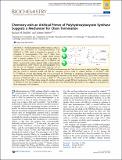Chemistry with an Artificial Primer of Polyhydroxybutyrate Synthase Suggests a Mechanism for Chain Termination
Author(s)
Stubbe, JoAnne; Buckley, Rachael M.
DownloadStubbe_Chemistry with.pdf (2.387Mb)
PUBLISHER_POLICY
Publisher Policy
Article is made available in accordance with the publisher's policy and may be subject to US copyright law. Please refer to the publisher's site for terms of use.
Terms of use
Metadata
Show full item recordAbstract
Polyhydroxybutyrate (PHB) synthases (PhaCs) catalyze the conversion of 3-(R)-hydroxybutyryl CoA (HBCoA) to PHB, which is deposited as granules in the cytoplasm of microorganisms. The class I PhaC from Caulobacter crescentus (PhaC[subscript Cc]) is a highly soluble protein with a turnover number of 75 s[superscript –1] and no lag phase in coenzyme A (CoA) release. Studies with [1-[superscript 14]C]HBCoA and PhaC[subscript Cc] monitored by sodium dodecyl sulfate–polyacrylamide gel electrophoresis (SDS–PAGE) and autoradiography reveal that the rate of elongation is much faster than the rate of initiation. Priming with the artificial primer [[superscript 3]H]sTCoA and monitoring for CoA release reveal a single CoA/PhaC, suggesting that the protein is uniformly loaded and that the elongation process could be studied. Reaction of sT-PhaC[subscript Cc] with [1-[superscript 14]C]HBCoA revealed that priming with sTCoA increased the uniformity of elongation, allowing distinct polymerization species to be observed by SDS–PAGE and autoradiography. However, in the absence of HBCoA, [3H]sT-PhaC unexpectedly generates [3H]sDCoA with a rate constant of 0.017 s[superscript –1]. We propose that the [[superscript 3]H]sDCoA forms via attack of CoA on the oxoester of the [[superscript 3]H]sT-PhaC chain, leaving the synthase attached to a single HB unit. Comparison of the relative rate constants of thiolysis by CoA and elongation by PhaC[subscript Cc], and the size of the PHB polymer generated in vivo, suggests a mechanism for chain termination and reinitiation.
Date issued
2015-03Department
Massachusetts Institute of Technology. Department of Biology; Massachusetts Institute of Technology. Department of ChemistryJournal
Biochemistry
Publisher
American Chemical Society (ACS)
Citation
Rachael M. Buckley, and JoAnne Stubbe. "Chemistry with an Artificial Primer of Polyhydroxybutyrate Synthase Suggests a Mechanism for Chain Termination." Biochemistry 54:12 (2015), pp. 2117-2125. © 2015 American Chemical Society.
Version: Final published version
ISSN
0006-2960
1520-4995